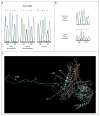Gigantism and acromegaly due to Xq26 microduplications and GPR101 mutation
- PMID: 25470569
- PMCID: PMC4291174
- DOI: 10.1056/NEJMoa1408028
Gigantism and acromegaly due to Xq26 microduplications and GPR101 mutation
Abstract
Background: Increased secretion of growth hormone leads to gigantism in children and acromegaly in adults; the genetic causes of gigantism and acromegaly are poorly understood.
Methods: We performed clinical and genetic studies of samples obtained from 43 patients with gigantism and then sequenced an implicated gene in samples from 248 patients with acromegaly.
Results: We observed microduplication on chromosome Xq26.3 in samples from 13 patients with gigantism; of these samples, 4 were obtained from members of two unrelated kindreds, and 9 were from patients with sporadic cases. All the patients had disease onset during early childhood. Of the patients with gigantism who did not carry an Xq26.3 microduplication, none presented before the age of 5 years. Genomic characterization of the Xq26.3 region suggests that the microduplications are generated during chromosome replication and that they contain four protein-coding genes. Only one of these genes, GPR101, which encodes a G-protein-coupled receptor, was overexpressed in patients' pituitary lesions. We identified a recurrent GPR101 mutation (p.E308D) in 11 of 248 patients with acromegaly, with the mutation found mostly in tumors. When the mutation was transfected into rat GH3 cells, it led to increased release of growth hormone and proliferation of growth hormone-producing cells.
Conclusions: We describe a pediatric disorder (which we have termed X-linked acrogigantism [X-LAG]) that is caused by an Xq26.3 genomic duplication and is characterized by early-onset gigantism resulting from an excess of growth hormone. Duplication of GPR101 probably causes X-LAG. We also found a recurrent mutation in GPR101 in some adults with acromegaly. (Funded by the Eunice Kennedy Shriver National Institute of Child Health and Human Development and others.).
Figures





Comment in
-
Genetics: X-linked acrogigantism--genetic characterization of a newly described paediatric growth disorder.Nat Rev Endocrinol. 2015 Feb;11(2):64. doi: 10.1038/nrendo.2014.230. Epub 2014 Dec 23. Nat Rev Endocrinol. 2015. PMID: 25534195 No abstract available.
-
Gigantism, acromegaly, and GPR101 mutations.N Engl J Med. 2015 Mar 26;372(13):1265. doi: 10.1056/NEJMc1500340. N Engl J Med. 2015. PMID: 25806919 No abstract available.
-
Gigantism, acromegaly, and GPR101 mutations.N Engl J Med. 2015 Mar 26;372(13):1264. doi: 10.1056/NEJMc1500340. N Engl J Med. 2015. PMID: 25806920 No abstract available.
-
Gigantism, acromegaly, and GPR101 mutations.N Engl J Med. 2015 Mar 26;372(13):1264-5. doi: 10.1056/NEJMc1500340. N Engl J Med. 2015. PMID: 25806921 No abstract available.
References
-
- Veldhuis JD, Iranmanesh A, Erickson E, Roelfsema F, Bowers CY. Lifetime regulation of growth hormone (GH) secretion. In: Fink G, Pfaff DW, Levine JW, editors. Handbook of neuroendocrinology. New York: Academic Press; 2012. pp. 237–55.
-
- Daly AF, Jaffrain-Rea ML, Ciccarelli A, et al. Clinical characterization of familial isolated pituitary adenomas. J Clin Endocrinol Metab. 2006;91:3316–23. - PubMed
Publication types
MeSH terms
Substances
Grants and funding
LinkOut - more resources
Full Text Sources
Other Literature Sources
Medical
Molecular Biology Databases
